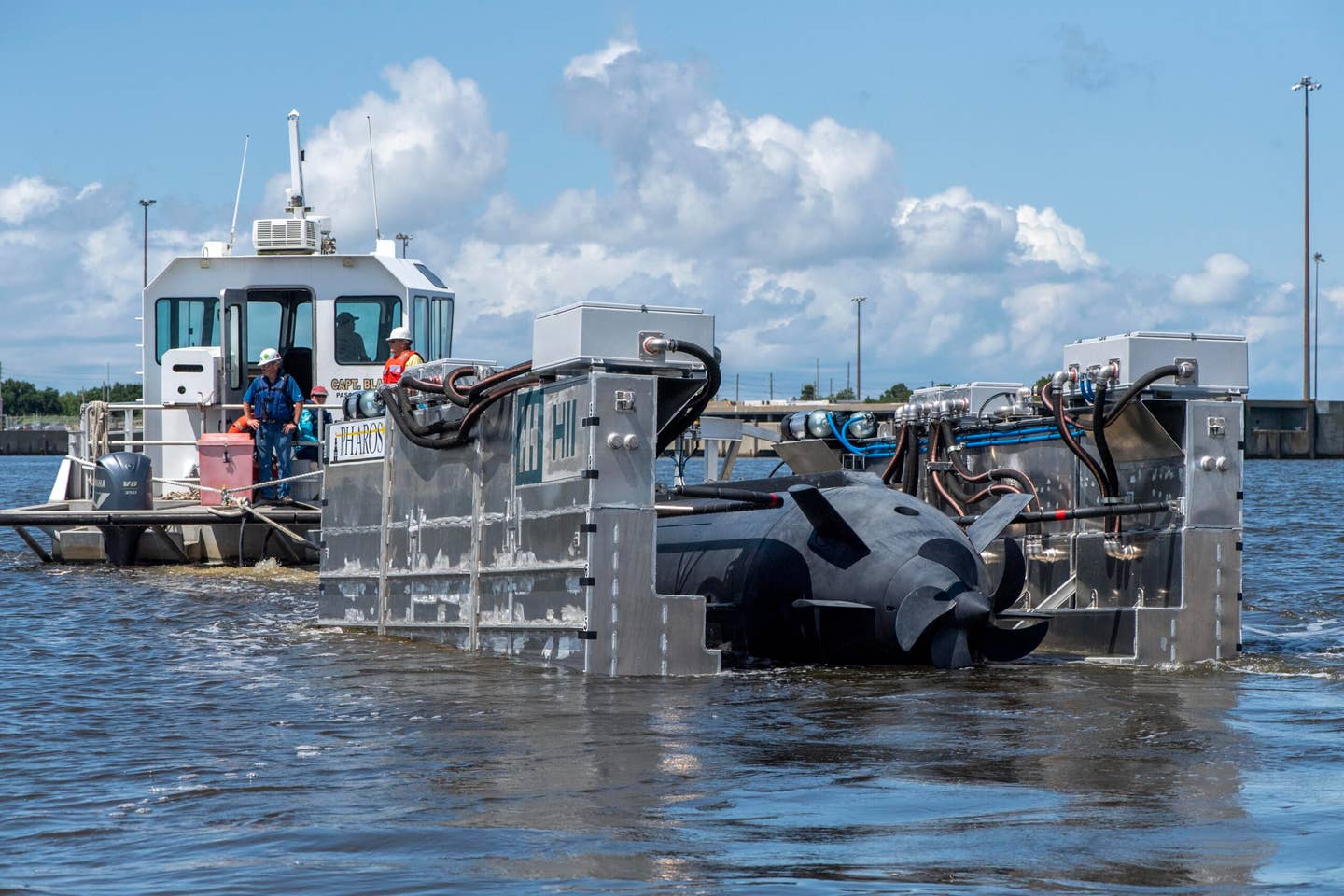The US Navy’s fiscal 2023 budget request had earlier revealed that the service plans to buy one more San Antonio-class amphibious ship before ending production, according to DefenseNews.
However, a new demonstration by Shipbuilder Huntington Ingalls Industries (HII) has hinted at new capabilities for the famed San-Antonio warships.
Huntington Ingalls Industries, or HII, has completed a test in Mississippi’s Pascagoula River, demonstrating that its San Antonio class amphibious warships can launch, operate, and retrieve Large Displacement Unmanned Undersea Vehicles (LDUUV).
The launch and recovery test was carried out by HII’s Advanced Technology Group using a prototype portable dry dock-like platform called Pharos and HII’s LDUUV Proteus, according to a press statement on June 13. The demo has hinted that the San Antonio class can become a ‘mother ship’ to LDUUVs.
The demonstration comes at a time when the US Navy is actively pursuing the Unmanned Underwater Vehicle program with several roadblocks in the form of issues with design, development, and the enormous costs incurred in the process.
Earlier this year, the US Navy planned to cancel the famed ‘Snakehead’ unmanned undersea drone research program following missteps during the design and procurement phases, Breaking Defense had reported.
Snakehead was an LDUUV designed to detect enemies underwater, carry a wide variety of payloads and carry out several missions underwater.
The US Navy faced issues with integrating the LDUUV with Virginia-class submarines.
“Misalignment of Snakehead [Large Displacement Unmanned Undersea Vehicle] design and procurement efforts with submarine hosting interfaces resulted in limited availability of host platforms to conduct Snakehead operations,” according to budget highlights book the Navy published.
The US Navy’s undersea drone plan is to create a family of systems, which means the military is working on several different UUV programs of various sizes and mission sets, such as the Orca Extra Large UUV and the Lionfish Small UUV.
However, the Navy still needs some way to launch and recover these UUVs after the issues encountered in launching the Snakehead from Submarines.
Against that backdrop, the HII test with a craft that resembled an amphibious ship assumes enhanced significance even as the Shipbuilder clarified that its demonstration was not aligned with any present Department of Defense (DoD) program.
San Antonio Amphibious Warship As ‘Mothership’
Pharos has heavy-duty wheels that allow it to operate within an amphibious ship’s well deck for stowage on the vehicle decks. Pharos can be rolled off the back of an amphibious ship and extended and retracted using its existing winch capabilities, allowing it to be launched and recovered from the rear well deck.
The Pharos design can be scaled and reconfigured to match a variety of unmanned underwater and surface vehicles. On the other hand, the HII Proteus LDUUV is a dual-mode undersea vehicle used as a Navy SEAL delivery vehicle and an unmanned undersea vehicle.
As part of the HII demonstration, the Proteus LDUUV first approached and was captured by the Pharos cradle. Then, at a low speed, Pharos was towed behind a small craft that resembled an amphibious ship (potentially a San Antonio).
After that, Pharos was set in a tow position and then ballasted down in the trailing position using a remote control, allowing the LDUUV to navigate into Pharos. The cradle was deballasted back up into a recovery and transport position once the unmanned vehicle Proteus was seized by it.
The demonstration also included ballasting down to launch the LDUUV after the capture. The entire test with the Pharos cradle and the Proteus LDUUV took place in the calm waters of the Pascagoula River.
Currently, Proteus LDUUV “is a test platform to facilitate the development of new autonomy capabilities and integration of the latest technology and payloads,” HII spokesperson Hernandez said. “In this case, it was used to demonstrate this launch and recovery capability of a large-diameter UUV.”
According to HII, Proteus is a large-class UUV that may be used to test sensors, autonomy, payloads, energy storage systems, and other technologies. It has forward-looking sonar, cameras, a variable buoyancy system, a baseline of 148 kWh energy, extended range choice, and a cargo volume of 170 cubic feet with external cargo capacity.

HII Ingalls Shipbuilding president Kari Wilkinson said: “HII is committed to advancing the future of distributed maritime operations and demonstrating our capability to support uncrewed vehicles on amphibious ships.”
In its media release, HII noted that its San Antonio class amphibious warships “have unique well decks that can be flooded to launch and recover various maritime platforms. The US Navy has previously demonstrated the ability to recover spacecraft from the amphibious warship well deck.”
A well deck is a hangar-like facility on the ship that also serves as a docking space for amphibious vehicles and landing craft. The San Antonio class is the only non-big-deck amphibious assault ship currently in production, even though there are other ships whose well deck can also be flooded for the purpose.
The fact that the San Antonio class can serve as a mothership for big unmanned undersea vehicles is an essential factor to consider as these new unmanned systems become increasingly important in future naval operations, said The War Zone.
San Antonio Amphibious Assault Ship
The US Navy’s newest amphibious force ship is the San Antonio class landing platform dock.
The San Antonio class’s role is to transport the ‘mobility triad’ of the US Marine Corps, including advanced amphibious assault vehicles (AAAVs), landing craft air cushion (LCAC), and the MV-22 Osprey tilt-rotor aircraft, to required locations across the world.
The ships are used in combat, humanitarian operations, and the recovery of space capsules.
With several Unmanned Underwater Vehicles under development and the trouble earlier faced by launching them from submarines, the San Antonio class of amphibious ships with advanced capabilities could assume the role of a launch pad or a mothership.
- Contact the author at sakshi.tiwari9555@gmail.com
- Follow EurAsian Times on Google News




